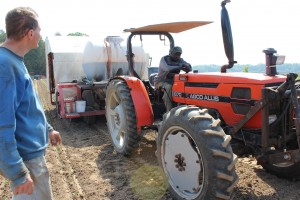Timing is key to getting plants in the ground, and establishing a steady cycle of planting, growing, and harvesting throughout the season.
In early spring, seedlings start to grow in greenhouses, to be transplanted as soon as the ground is ready. A tractor pulls the transplanter slowly through the fields, releasing a steady stream of water to prepare the soil.

Technical difficulties – a flat tire. Waiting patiently for the air compressor.
A team of 4 who are seated side by side under the canopy drop the seedlings into the ground, while a second team follows behind to make sure the seedlings are firmly and properly placed.
Plants that are transplanted as seedlings can be harvested earlier, giving time for those grown directly from seed. Once a field is harvested, planting can begin again – most often with a different crop. The nutrients left behind from the harvested plants are used by the next crop grown. Crop rotation works! And the health of the soil matters. No monoculture here.
This year, we are excited to try out our new 8-row planter. Seeds are planted in double rows, instead of the single ones we are used to. For bunching crops, this will result in increased yield per acre. It should also provide greater weed control, as the more densely grown crops ought to choke out any weeds more effectively. We are also hoping that there will be less dirt splatter during heavy rains, which is definitely noticeable in the single rows. It does not affect the quality in any way, but it’s not very aesthetically pleasing! So far it seems to be going well.

Week 1

Week 4
The work continues!












